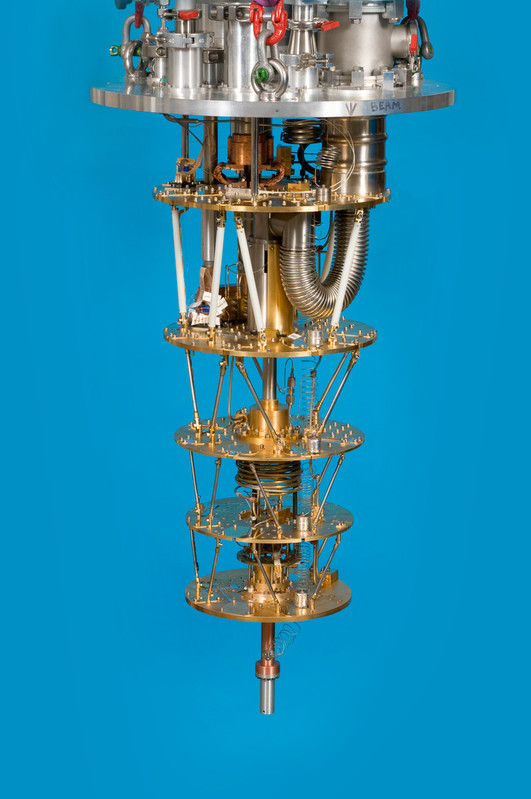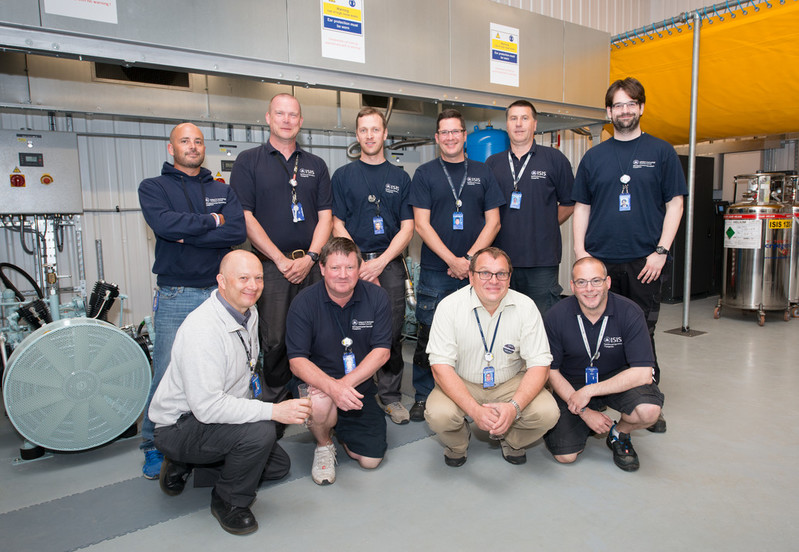About 500 experiments at ISIS each year require cooling using cryogenic liquids such as nitrogen and helium. Just over one hundred of these require what's known as ultra-low temperatures, when the conditions needed are below 1 Kelvin, or -273°C.
These experimental conditions are extremely challenging to create; even the energy of the beam can make the sample too hot, as can local vibrations. The number of requests for this type of experiment has increased over the last ten years, making ISIS one of the most intense users of ultra-low cooling systems in the world.
To create these ultra-low temperature environments, the cryogenics group use dilution fridges (an example is pictured below). These rely on quantum mechanical effects that occur when two isotopes of helium are mixed. By diluting a mixture of helium 4 with the much rarer isotope helium 3, we can achieve cooling due to the heat of mixing of the two isotopes. This cooling occurs when helium 3 flows from a pure 100% helium 3 phase to a lower purity 'dilute' phase.
“This is a rare opportunity to see the macroscopic consequences of a quantum mechanical effect," explains Chris Lawson, the ultra-low temperature technical manager. “At these temperatures, all the tiny things matter, with even the friction of the helium against the walls of the dilution fridge pipework causing warming."
 This leads to geometric constraints adding to other factors that create a limit to how cold this type of cooling equipment can get. Most ultra-low temperature experiments at ISIS need to be cold enough that thermal fluctuations do not contribute to the behaviour of the atoms, and the 25-30 mK created by the dilution fridges is good enough for this.
This leads to geometric constraints adding to other factors that create a limit to how cold this type of cooling equipment can get. Most ultra-low temperature experiments at ISIS need to be cold enough that thermal fluctuations do not contribute to the behaviour of the atoms, and the 25-30 mK created by the dilution fridges is good enough for this.
However, there is a demand from some users to go even colder, which would require a different method that we don't have at ISIS (yet!). “Adiabatic nuclear cooling is another option." Explains Chris; “Once below about 30 mK, you can use magnetic fields to manipulate the spins of the sample, cooling them to temperatures well below 1mK, even to microkelvin temperatures."
Once you get to temperatures that low, even knowing how cold it is causes challenges. The team would have to calibrate their thermometers by measuring the thermal motion of the atoms, or by studying the melting point of helium.
To make sure that all accepted experimental proposals are feasible, the Sample Environment group leader sits on the ISIS Facility Access Panels. One recent experiment saw a sample need to be kept at ultra-low temperatures for a month between measurements. This needed some careful signage on the power points to make sure no-one switched off the plug!
As the equipment and skills needed to run these experiments are limited, the team can only run a limited number of them a year, and regularly meet this maximum. As the appetite for this type of experiment continues, the team are bringing in new equipment and staff.
As this job doesn't exist outside of large facilities, they bring people in with diverse skills and then train them up; “I am an academic physicist, working alongside electricians, machinists and even a car mechanic," explains Chris.
“We also have a number of development projects ongoing: we are hoping to image the dilution fridge mixing chamber using IMAT to see what's going on inside. Working here brings the freedom to run with a good idea: the attitude is very positive and encouraging."
As well as keeping the samples themselves cool, some of the other special sample environments at ISIS also require cooling using liquid helium. This includes superconducting magnets that can create fields of over 10 tesla. In comparison, a hospital MRI goes up to about 4 tesla.
Although you may think of it as a common resource used for filling balloons, helium supply is actually very limited and it is therefore very expensive. Although liquid nitrogen can be bought for the same price as milk, “standard" helium is more like £15 per litre, and the helium isotope used for the dilution fridges can be up to £2000 per litre!
Because of this, at ISIS, the helium used for cooling is recovered from the experiment and re-used. The recovered helium is transported through a few kilometres of pipework and stored in a large balloon, which had to be manufactured by a marine environment company so that the material can hold the helium inside. Chris explains; “helium is very small and lively and so it takes a lot of effort to stop it escaping. It's worth it though to reduce the amount we use."
As well as their day job, the cryogenics team are very active members of the ISIS public engagement programme, running a liquid nitrogen show and developing new ways to engage the public with super low temperatures.

ISIS R108 Helium recovery facility opening, 2016. Image shows left to right, back row;- Jonathan Timms, Paul Frodsham, Mark Devenport, Dave Bunce, Ian Bradshaw and Christopher Lawson. Front row;- Richard Down, Jeff Keeping, Oleg Kirichek and Robbie Major.
